You have read the public side of the Sensei fraud at the Tata Institute of the National Center For Biological Sciences (NCBS) in Bangalore, India, which resulted in a retraction of a once celebrated paper in Nature Chemical Biology. You may have read the institutional statements, and The Wire article, where we learn how an intrepid principal investigator Dr Arati Ramesh was betrayed by a snake student, who stole and destroyed all her perfectly reproducible discoveries of iron-sensing RNA, then stealthily replaced them with Photoshop fakeries and skedaddled. How the defiant Dr Ramesh uncovered his fraud and heroically retracted her own paper, by her own executive decision, and how her lab grew stronger from this challenge, and how her peers now salute her for her bravery and integrity.
Ah, what a story. There is another version though, told in the emails by Ramesh and by that same accused student, Siladitya Bandyopadhyay. NCBS was asked to comment on the summary of these allegations, but instead warned me that that all these claims are “factually inaccurate, anonymous, and unverified“, and even “quite frankly, can be termed slander“, but refused to say which claims exactly.
The emails allege that research misconduct was standard practice in the Ramesh lab, that students were never taught how to do controlled scientific experiments, but instead bullied when they didn’t deliver the pre-defined results. Apparently, one student was assigned as a scapegoat from the very beginning. NCBS was not interested in investigating the main cause of fraud, and tried to bury the affair with a quick retraction, which the journal already decided upon anyway. Ramesh has been misinforming the scientific community, on PubPeer, on her lab page, even in her email to the journal.
“you can rest your concerns“
This was the paper, published on 5 October 2020 and retracted on 30 June 2021:
Siladitya Bandyopadhyay, Susmitnarayan Chaudhury, Dolly Mehta , Arati Ramesh Discovery of iron-sensing bacterial riboswitches Nature Chemical Biology (2020) doi: 10.1038/s41589-020-00665-7
The PubPeer comments exposed data manipulations in October 2020, Ramesh insisted “we have not manipulated any images” and provided what she called “original images”, with the expectation “so that you can rest your concerns” and “so that no doubt remains.“. That purported original images proved fake, despite Ramesh’s insistence that they “have TIME STAMPS showing that they were performed on different days”. The principal investigator also wrote:
“We are more than happy to share all the reagents, constructs and materials and a detailed protocol for ANY of these experiments so that anyone can corroborate the results of the experiments shown in the manuscript.“
Which is a strange offer, given that her own later official version of events insinuated all these materials were stolen by the rogue student. But then again, Ramesh is one of those PIs who works a lot in a lab herself, she even has her own freezer space. So the above statement doesn’t really fit the official version of all reagents and stocks having been stolen and destroyed.
In that statement on NCBS website, Ramesh blames her former student Siladitya alone:
“The specific data that were flagged came from one author, who left my lab abruptly within a few days after the investigation (without turning in the correct constructs/strains related to this project and without sharing some of the ITC raw data).”
Truth is, the student never left “abruptly”, Ramesh is, shall we say, being dishonest here. Or maybe in denial. In reality,upon the completion of a two-week investigation, the student submitted an employment termination request, which was approved, and he also received from NCBS a “No Objection Certificate” (NoC), to help him with a future employment elsewhere. Here an email to the student from NCBS director Satayjit Mayor, dated 4.12.2020:
“I am following up our conversation yesterday regarding the findings of the investigation committee that is as noted below: I am excerpting the Committee report submitted to us on Nov 24, 2020, as discussed with you and now attached for your information. […] I accept your resignation under the conditions that we discussed:
1) You provide us in writing an acceptance of your wrongdoing, and clarify the circumstances and the names of the persons who have helped you committing this fraud.
2) You complete all formalities required for obtaining the NoC as discussed with you.
Failure to comply with either of the above will result in a termination notice to you, with consequences for your record.
I am sorry that your moving on from NCBS could not have been in better circumstances, but i hope that these mishaps and mistakes from your side will not be repeated and you will learn from them and move on.“
How sausages are made
To obtain this NoC letter, the student was asked to reveal all other issues of data manipulation he was aware of. Which he did, and it doesn’t flatter Ramesh’s leadership style at all.
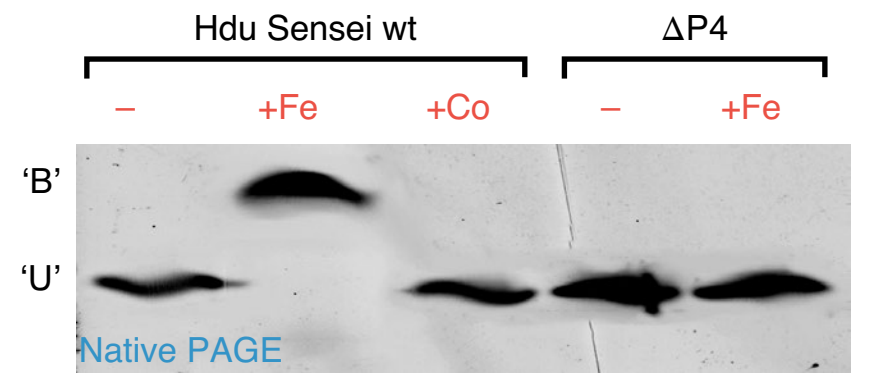
Read yourself what evidence the student provided to the NCBS investigators, I highlight key passages and illustrate the student’s explanations with relevant figures from the retracted Nature Chemical Biology paper.
“Fig 3e: This figure shows that the Sensei RNA changes its structure with response to a ligand. This experiment was repeated multiple times, but every time the shift was much higher than it is shown in the figure. In spite of repeating the experiment multiple times, Arati was not happy with the shift that we obtained each time, so the band shift was moved a bit lower as was required.“

“Fig 4bcd, Ext fig 8c: All the blots in question correspond to the Fe Biosensor which shows that in the presence of iron, the protein expression increases by around 8 fold. This experiment has been repeated by multiple students in the lab including [….] and we all concluded that the protein expression does increase in the presence of iron. Initially when we started with the experiment and when it was concluded that the expression is increased, we did not run a loading control ever. More recently, when we decided to publish this data, we started running the loading control (RpoA) in a separate blot alongside the overexpression blot. Since our protein size matches that of RpoA, we ran the loading control on a separate blot, and this is the standard practice in the lab.“
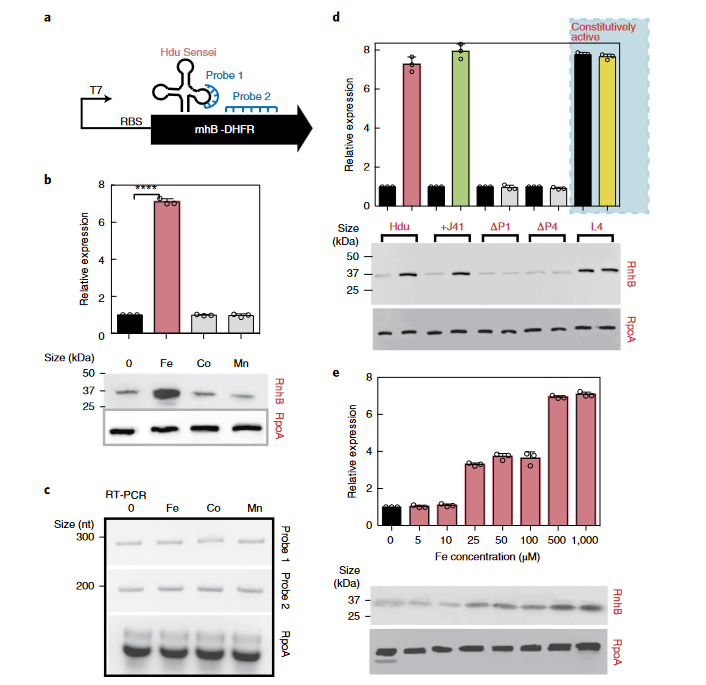
“Just a few days back after talking to my friends in other labs, I started to realize what loading control actually means and that a blot can be stripped and reprobed with another antibody to obtain a blot and this is the only correct way of doing it. This was never taught to me or is practised in the lab. Due to this, every time when someone repeated this experiment, the overexpression pattern used to change (sometimes it was 8 fold, sometimes it was 5 fold etc).“

“The original blots for the multiple attempts are attached in my lab notebook. I did a densitometry analysis on the two bands in ImageJ which showed that the expression is 4-5 fold and this was obtained a majority of the times the experiment was repeated, but Arati felt after looking at the blot that the overexpression was 8 fold so we will have to bring the pattern as 8 fold even after using a separate blot for loading control. If you see earlier experiments repeating this blot in my notebook, you can see that the overexpression pattern is really not 8 fold and there is a degradation band below the original band.”
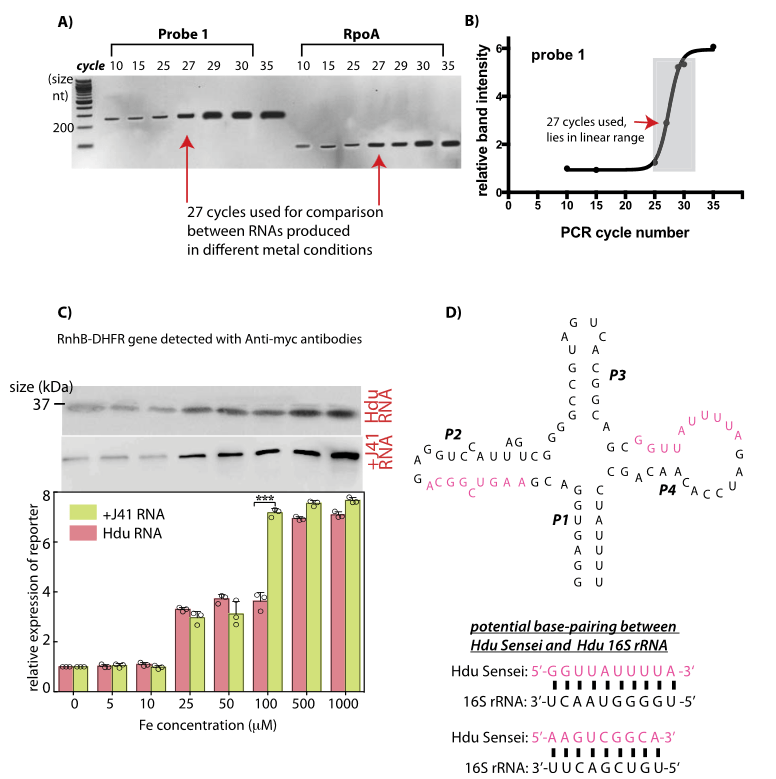
“We also repeated this experiment multiple times and every time the degradation band was visible. Arati wanted the blot to be clean under any circumstances and so she suggested that we use Bead beating (a method used to lyse yeast cells, or any cells with an intact cell membrane) instead of Sonication (that is a standard practice of lysing cells like bacteria). Even after repeating the experiment with bead beating multiple times, the same pattern was visible as earlier and Arati was not convinced about it. So, the lower bands in the original blot were removed and just the overexpression band was kept. Also, I have recently realized that we cannot conclude anything from an overexpression blot if the loading control is not used, so what I understand now is that the entire experimental setup was wrong.“
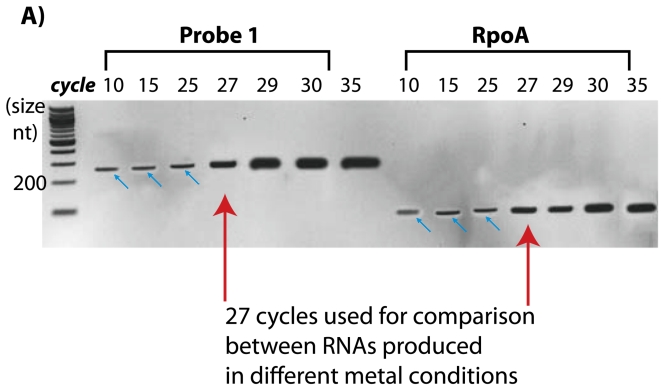
“Fig 1g: This data was generated by […] and you can find this in his lab notebook copy number 2. This data shows that the mutant RNA does not bind to cobalt and iron. I just came to know a few days back that RNA was not even used in this experiment at all. EDTA has been used instead of RNA, and Calcium chloride was used instead of iron and cobalt. I still do not know how this reaction really works, but this is what happened. Also, if you check […]’s box labelled “RNA and metal solutions for ITC” in the -20 RNA freezer in our lab, the tube labelled as “RNA for ITC” is not even RNA. You can understand this if you take this sample and measure the concentration on Nanodrop or even run on a gel. This is for one mutant of RNA. He also did this ITC for another mutant, where the same set of chemicals were used and this will also be there in his lab notebook.“


NCBS did not care. They gave the student the No Objection Certificate, then blamed him for everything, retracted the paper and declared Ramesh to be his innocent victim. The case is closed. Scientists have been congratulated their friend Arati on slaying the snake and arising victorious.
As one computational biology colleague in Chennai, who once hosted Ramesh’s seminar, commented under my earlier article:
“In short, this was handled exactly as it should be, by the PI, the institution and the journal (and also the pubpeer community). […] I know the PI a little (and have visited NCBS often and can vouch for the leadership’s uprightness). I do not believe the PI would have pressurised the student to fake data. […] As for Schneider, he has an agenda. Previously he has posted toxic and borderline racist tweets on Indian science.“
Bullying in an Elite Lab
This was Siladitya’s experience of working in Ramesh’s lab, told in an email from 23 November 2020 to NCBS internal investigators (highlights mine):
“When I joined the lab in 2017, I didn’t even know how to cast an agarose gel or how to even do a simple PCR. I was told that I have to replicate the data that was generated by someone in the lab and if that does not happen, I will never get to stay in the lab. I was told to replicate a fluorescence data and before that I have never known how to even do fluorescence. I have several emails giving me manipulated images, but I really do not want to use anything now since the allegation is against me and I am ready to accept whatever action is taken against me. Since the first day I stepped into the lab in Dec 2017, I have seen someone manipulating data, for example, the NiCo story [possibly related to Furukawa et al Molecular Cell 2015, -LS] But again, I do not want to take the person’s name here solely because he taught me a lot of techniques that I have mastered over the past 3 years and I am grateful for that.
Numerous people left the lab in the past years in literally two months of joining. I can think of two interns, […] who simply left the lab without informing anyone. […] literally left the lab in a week and we never got to know why he left.
[…]
One time there was a girl named […]. She made glycerol stocks at the final concentration of 25% Glycerol which is generally used all over and mentioned in almost all protocols on the web. Arati threw away all her stocks because she wanted the amount of glycerol in the stocks to be 30%. This has happened in front of me.
I honestly want to tell you that I have really never learned how to actually do science, let alone manipulate data. I know that after this incident I will probably be expelled out of NCBS and I know this is what should happen to me but if I ever get a chance to do research in life, I really want to learn how science is actually done and how it works. I really want to get the whole idea of how troubleshooting is done, that all my friends in other labs talk about. I know it’s hard and takes a lot of time and effort, but I really want to learn that someday if I ever get a chance. I was reproducing all experiments in front of […] and Arati in the lab.
So, one day when my native gel was not getting reproduced by other members in the lab, […] told me to start another set of experiments at 8.30 PM which would take another 4-5 hours to complete, I refused to do it that day. They started forcing me to do the experiment that day, and I was working from 8.30 in the morning, so this was too much for me. So, I myself told Arati and […] in our lab that I want to retract the paper and I do not want to work any further in this lab. I honestly do not even know how this whole system works and I have never had a publication before, nor have I ever worked in a lab. “
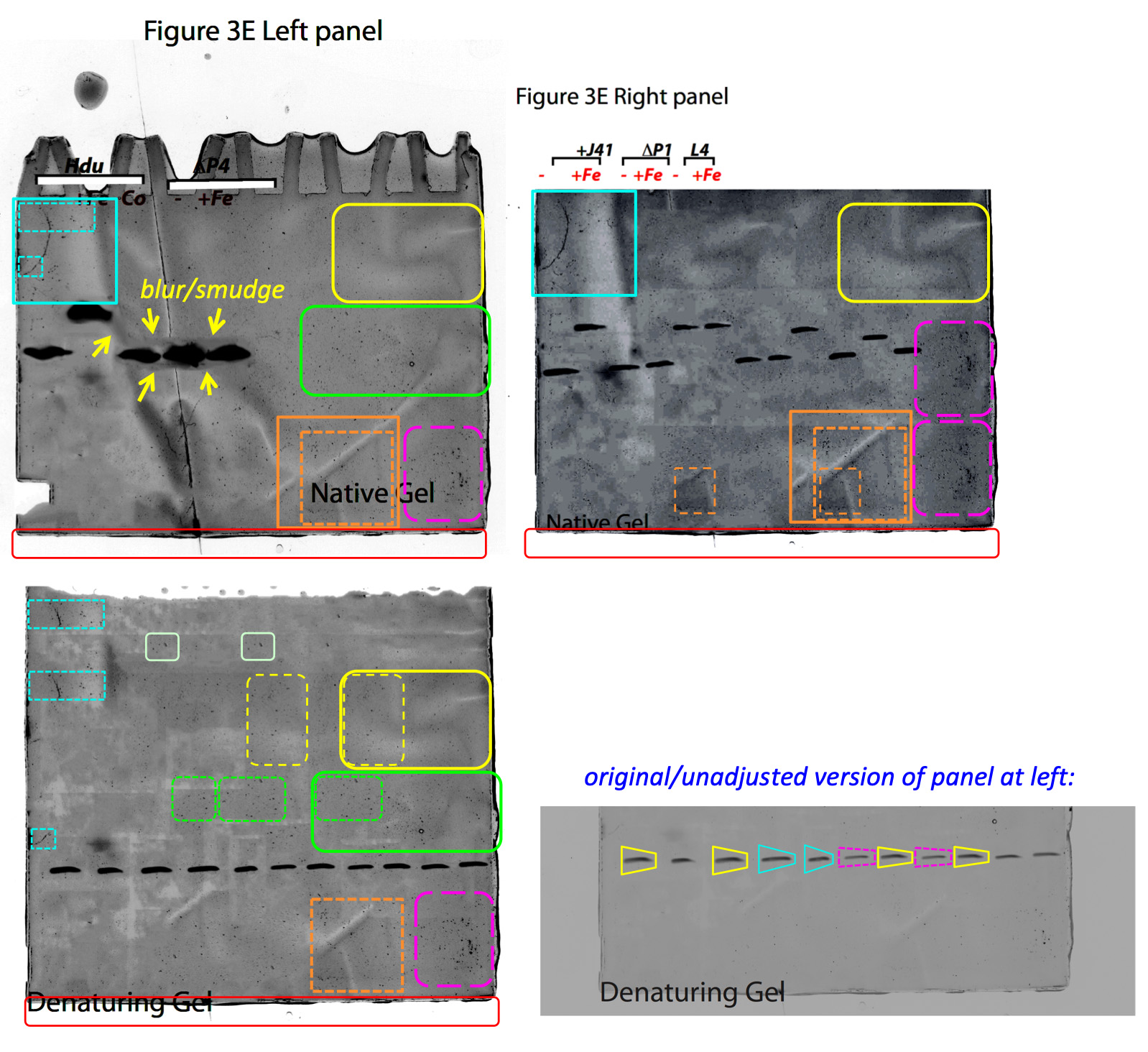
The Fortnight Investigation
According to my information, the investigation started also on 7 November 2020, a Zoom meeting was set up on that day. That was after Ramesh told everyone on PubPeer to “rest your concerns” with her fake raw data, and after the journal was informed. There, as a source revealed by sharing a relevant email from a lab member to Ramesh:
“during a zoom meeting, you had mentioned that you will communicate the iron riboswitch work into another journal if the NCB retraction takes place.”
Ramesh never replied to me when asked to oppose this or any other allegations against her. In the emails from early July 2021 which I was privy to, she was at least not in a hurry to re-publish the retracted paper, but she certainly did not exclude this option. The investigation ended, as the email from the director above explains, on 24 November. See how quickly the NCBS experts solved this whodunit mystery and closed the case? TWO WEEKS. Ruthless efficiency!

On 30 December 2020, after the published editorial note from 11.12.2020 promising “Appropriate editorial action“, Ramesh wrote to her lab members:
“Dear Susmit, Siladitya and Dolly,
You are all aware of the concerns raised regarding the NCB paper. In light of the concerns and the investigation that followed, I have been advised by the institute and the journal to retract the paper. I also share the same concerns about some of the work shown in the paper and hence agree that the retraction is the only course of action.
If you have any objections to the retraction, please let me know ASAP. Also, you will be asked to sign the retraction statement. If for any reason you are unwilling to sign the statement, please let me know ASAP.
-Arati”
Wait, were we not educated that it was Arati’s own independent decision to retract the paper? Didn’t she explain to us, on her lab’s website:
“We found that the native gels were not reproducible. Given that the Fe-induced structural change in Sensei RNAs, as shown by the gels, was an important finding reported in this paper, we felt that retraction of the work in its entirety was essential.“
Turns out she only felt that after both Nature Chemical Biology and NCSB informed Ramesh that they decided to retract her paper?
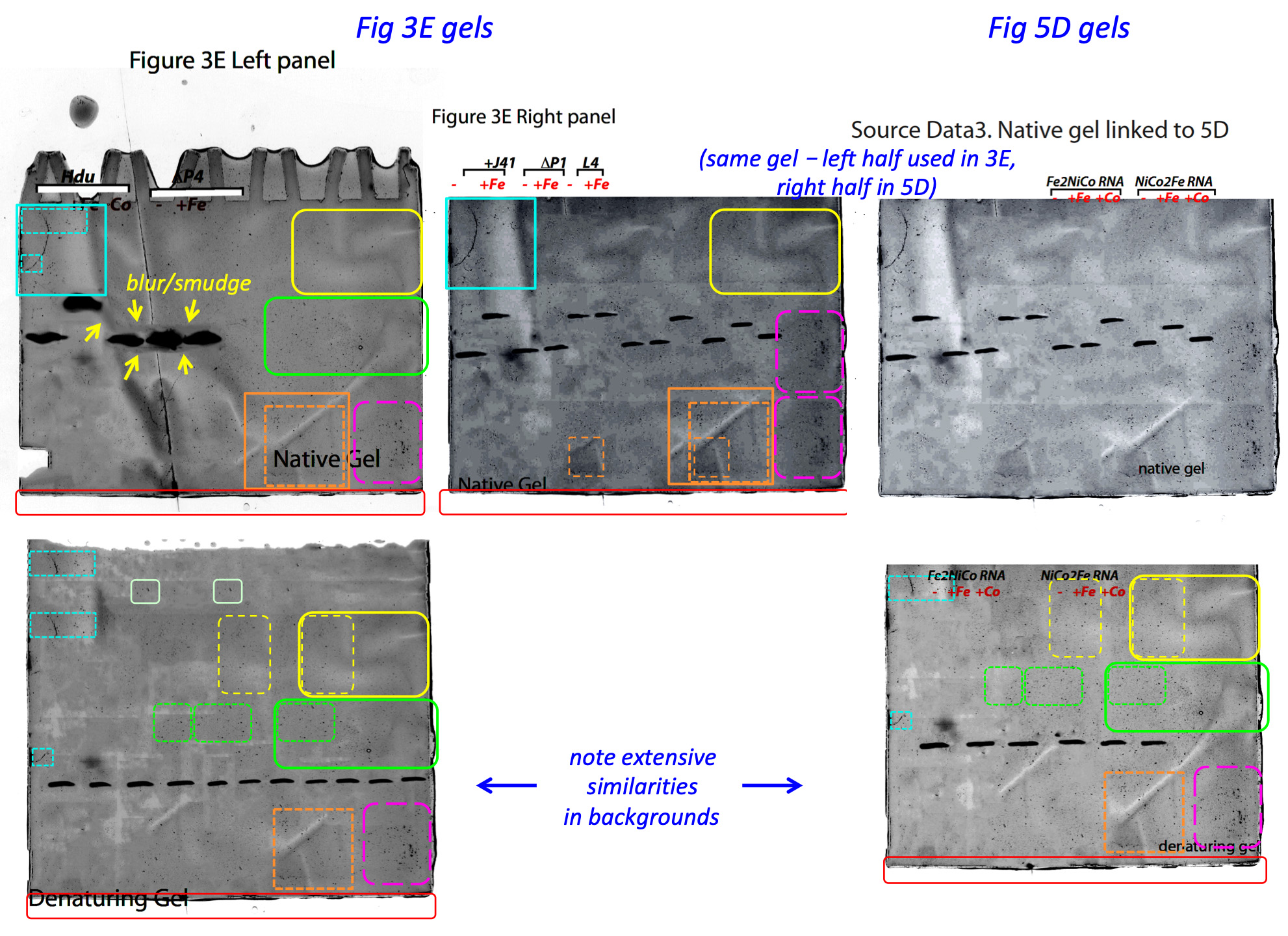
Afterwards, Ramesh wrote to the journal’s editor, Terry Sheppard, some time in January 2021 (highlight mine):
“Dear Dr. Sheppard,
Thank you for your patience regard our manuscript and the concerns raised.
We have now fully assessed the comments raised on this work and present a detailed note on this below.In addition, an independent investigation by my institute has made it clear to us that some of the data presented in the manuscript are suspect and has features that are inexplicable to us. The specific results that been tagged were provided by one author (S.B.), who was unable to explain these features. This individual has abruptly quit my lab end institute in November, following these investigations. He has also not responded to my email asking if he would be willing to sign a retraction statement.
The authors SNC, DM and I (AR) agree that the concerns raised are valid. We agree that in the interest and correctness of the scientific process, a retraction of this paper would be a way forward. We three agree to sign a retraction statement. I hope that we can work closely with the journal to write this statement.
I am devastated and truly sorry that this could happen under my watch. Once again, this is extremely painful and we appreciate your patience with this very unfortunate and unpleasant matter.“
Well, here is what happened according to the accused student Siladitya, as he wrote on 2 February 2021:
“Dear Arati,
Hope you are doing fine.
This is regarding the NCB paper. I recently came to know from an Arati lab member that I have not agreed to the decision of retraction regarding this paper. Also, I have heard that I haven’t replied to any of the calls or emails that you have sent me recently. Additionally, I have also come to know from a screenshot of the retraction email sent to NCB by you, that I have not agreed to the retraction as I could not be contacted.
The last email that I received from your side on 30th December 2020 was titled “important: regarding NCB paper”. This email didn’t demand any reply from my side, and as mentioned in the email, I only had to respond if I have any objections to the retraction, which I don’t have. I just want to let you know that I have not received any calls or emails from your side following this.
I had told you the day I last went to the lab that I want to retract the paper, and I have told this repeatedly to everyone else of the campus I talked to in the following times.
I just want to state upfront to clear the confusion: “I AGREE TO THE RETRACTION OF THE NCB PAPER (doi: 10.1038/s41589-020-00665-7)” I could not agree more.“
Ramesh replied to that:
“Thank you for clearly stating that you agree to the retraction. I have informed the Editor of your agreement.“
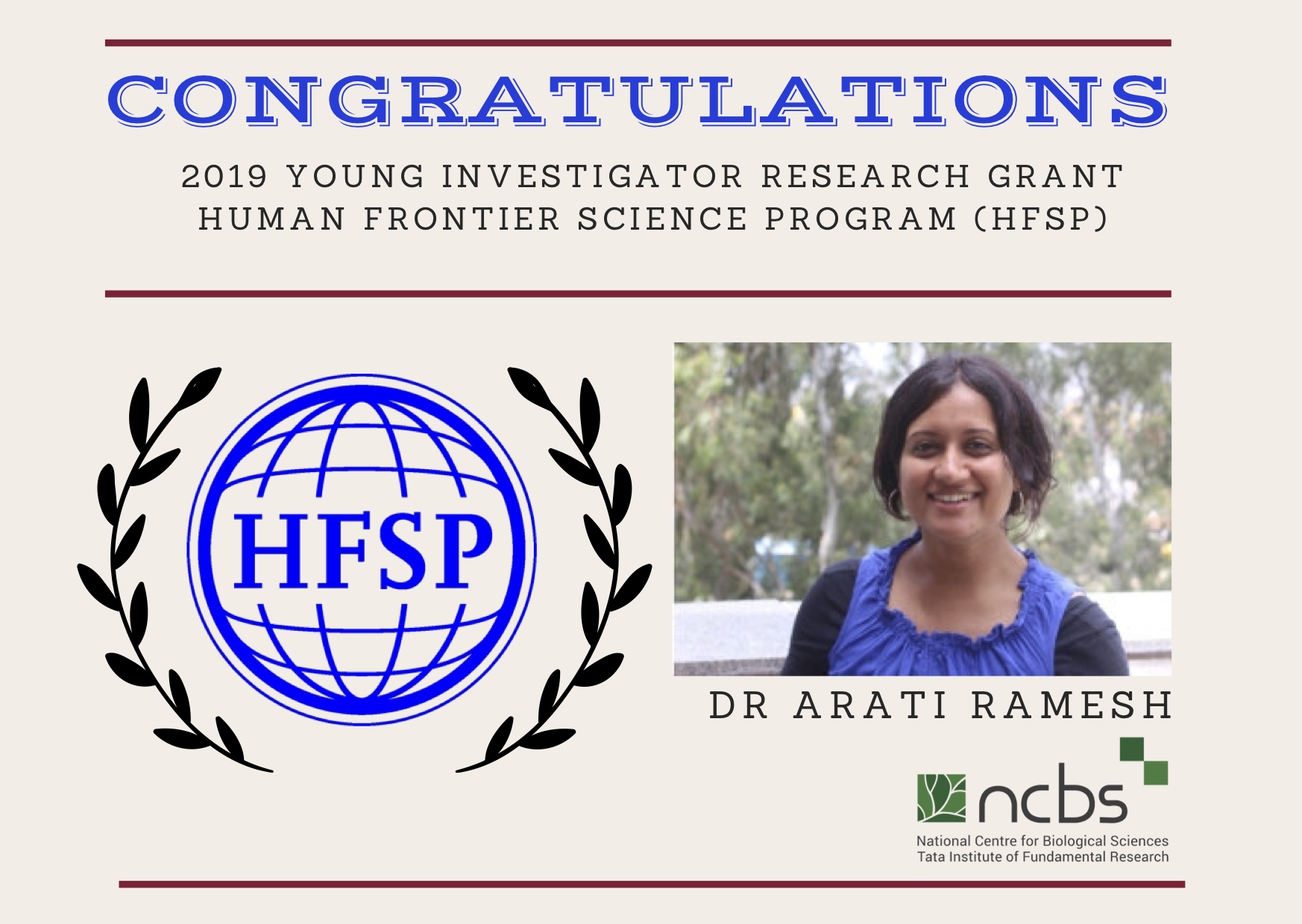
Revenge!
The paper was slotted for retraction. But it didn’t end there. Here another email from the rogue student, dated 17 April 2021, sent to some NCBS researchers (highlights mine):
“I wanted to inform you something. I am Siladitya, a past Arati lab member, I left the lab in December. I hope you remember all the incidents and wrong-doings from my side. I have been recently informed by an Arati lab member, […], that Arati has come to know that I have joined […] Biosciences, and she has threatened the lab to destroy my career by emailing the directors of […]. […] called me and said that she is facing the same instances as I have faced and she feels horrible. I never even imagined something like this can ever turn up, so even after confessing all my wrongdoings, I myself informed all of you that I have joined this company and would work honestly and I have really continued to do so. “
Was someone trying to take revenge and bully everyone into silence here? As Ramesh wrote in that public statement:
“The foundation of my lab is built on several pillars: trust, empathy, hard work and collaboration.”
Neither Ramesh nor NCBS are willing to talk about any of that, and the institute spokesperson made clear to me, with Ramesh in cc, whom they see as the real baddies: the whistleblowers. So here is a brief guest post by my new contributor, the pseudonymous “Paul Jones“. It is about Ramesh’s husband, Sunil Laxman, group leader at InStem in Bangalore.

Sunil Laxman did the right thing, too
By “Paul Jones”
A rogue student hoodwinked the National Center For Biological Sciences, one of the country’s most prestigious institutions. As the victimised PI stated, the villain fled with the RAW DATA, the correct constructs/strains, and perhaps the instrument too.
In the aftermath of the incident, many respected scientists came to Dr Ramesh’s defence, quite irrationally. A few even went so far as to accept responsibility for any subsequent incident. But, alas, a second strike did come. As opposed to the previous case, the image here wasn’t altered in any way, just the data, we suppose.
Dolly Mehta , K. Anjali , Arati Ramesh Discovery of ANTAR-RNAs and their Mechanism of Action in Mycobacteria Journal of Molecular Biology (2020) doi: 10.1016/j.jmb.2020.05.003
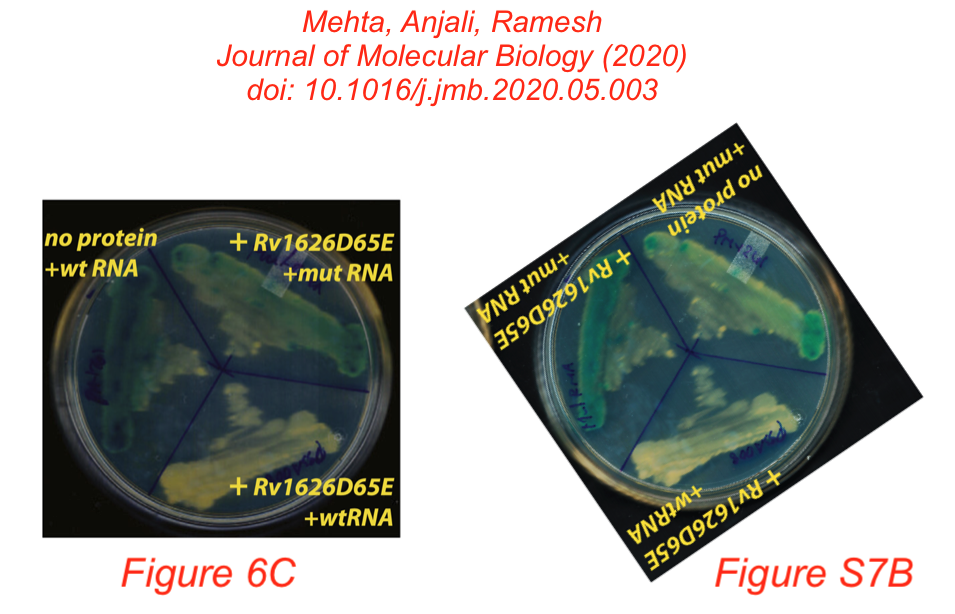
Leucanella Acutissima further illuminated our understanding on PubPeer by saying,
“It is one thing to realize a mistake and relabel. It is quite another thing to take a photo first, then relabel afterward, then take a second photo, and then use BOTH photos in the paper and portray them as different experiments.”
The corresponding author is likely to be defended by many who say that the data is MOSTLY RIGHT. Unfortunately, this time the accused on the first paper was nowhere to be seen on the second. What are our options here? Should we blame the junior first author again here? Maybe also this data has already been stolen, or perhaps this student also left abruptly?
Without mentioning his tiny conflict of interest, the husband of the corresponding author, Dr Sunil Laxman offered to provide an explanation on Twitter. Dr Laxman is quite an influential faculty at the Institute For Stem Cell Science and Regenerative Medicine, and also happens to share critical comments on all Ramesh manuscripts.
Another concerned biologist from NCBS, Dr Deepa Agashe declared on Twitter to “feel comfortable speaking up” because she happened to “know something about this case” when she came across “unfair questions” where her “colleague at NCBS” was concerned. Do you know something about the second case too, Dr Agashe?
In addition, this incident polarized the student community. Not only eminent faculties, but also eminent ex-graduate students (who happened to share the adjacent lab) expressed concerns regarding the ethics courses being issued at the institute. A well-known ex-graduate student of NCBS was concerned about external graduate students not getting enough “compulsory orientation of scientific ethics” anymore. Like, things like these didn’t happen in mine and Arati’s days, the rotten youth of today [head shaking].
I ask here, do faculties go through the same ethics course that enables them to publish fraudulent research, not once, but twice, Dr Chakraborty? If a former Science Slam winner 2018 and FameLab India Finalist like you could irrationally support this student-blaming exercise, even though the evidence of PI misconduct was quite plain to see from the start, can we really trust your own science now? As you yourself said, “Fighting Fire with Fire”.
What we have learned from this story is that, when it comes to eminent scientists with a long list of publications under their belts, there is only one belief:
The Principal Investigator is infallible and innocent. The student did it.
As Dr Laxman perfectly objectively said, his wife’s retracted paper was never completely fake, but:
“Mostly right. But some things happened beyond twitterverse and the senior author was incredibly brave and did the right thing.“
But to our HORROR, several science integrity sleuths at PubPeer pointed out similar image duplications at two of Dr Laxman’s own papers from 2005 and 2006. The flagged papers are likely to have been part of Dr Laxman’s PhD thesis, and were written under the same corresponding author. I regret to inform you, Dr Laxman is the junior author here.
We weren’t finished yet. More fabrications were on their way. Identical authors shared two more articles flagged on PubPeer, Dr Laxman merely being the corresponding author here. In the first paper flagged from eLife, the first author Sriram Varahan boldly remarked that there were differences between the flagged images, and stated “We would like to reconfirm that the colonies used in Fig 2F of the manuscript are all unique colonies” which may simply “look very similar, but with minor differences”. Unknown circumstances led to a Correction being issued for this article, where the image was replaced anyway, with “no change to the conclusions made in our paper“.
However, the second article from the same group, with exactly same authors, has yet to receive any responses from the authors.
Sriram Varahan, Vaibhhav Sinha , Adhish Walvekar , Sandeep Krishna , Sunil Laxman Resource plasticity-driven carbon-nitrogen budgeting enables specialization and division of labor in a clonal community eLife (2020) doi: 10.7554/elife.57609
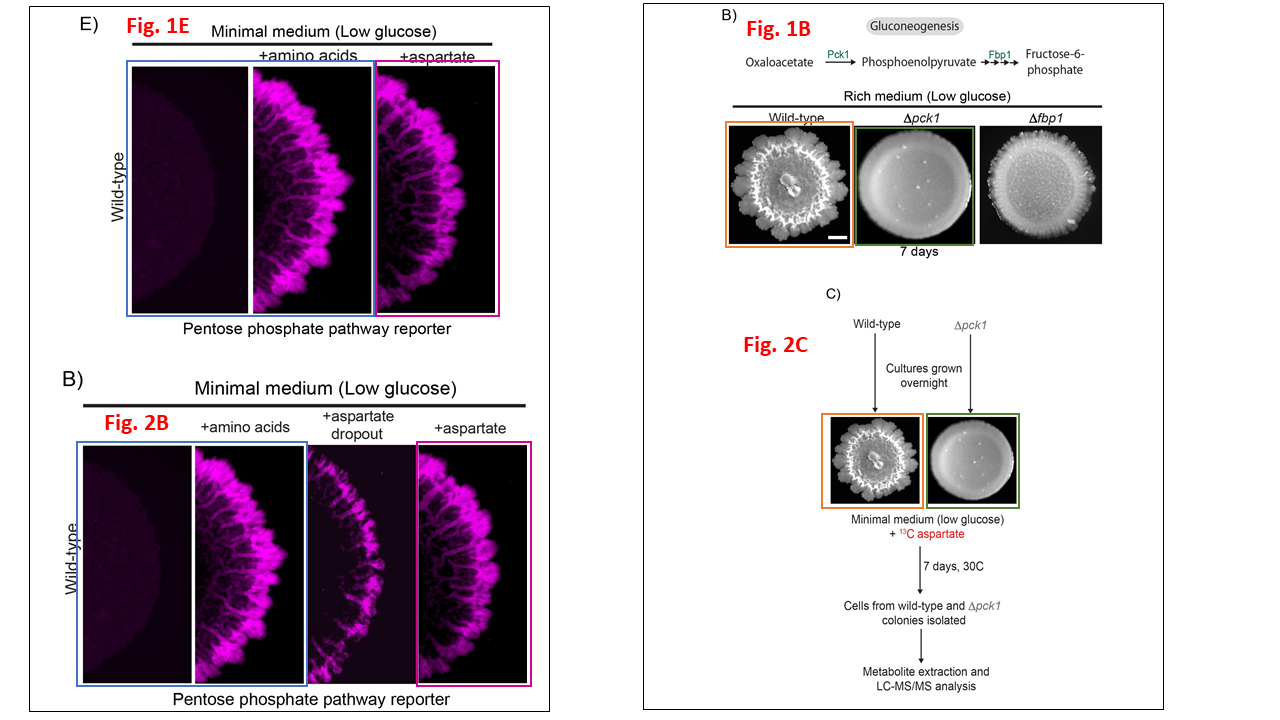
I cannot “rest my concerns” because the authors are not replying anymore. Are they probably still searching for the data, maybe it has been stolen also? Are the images just similar? Are the conclusions affected?
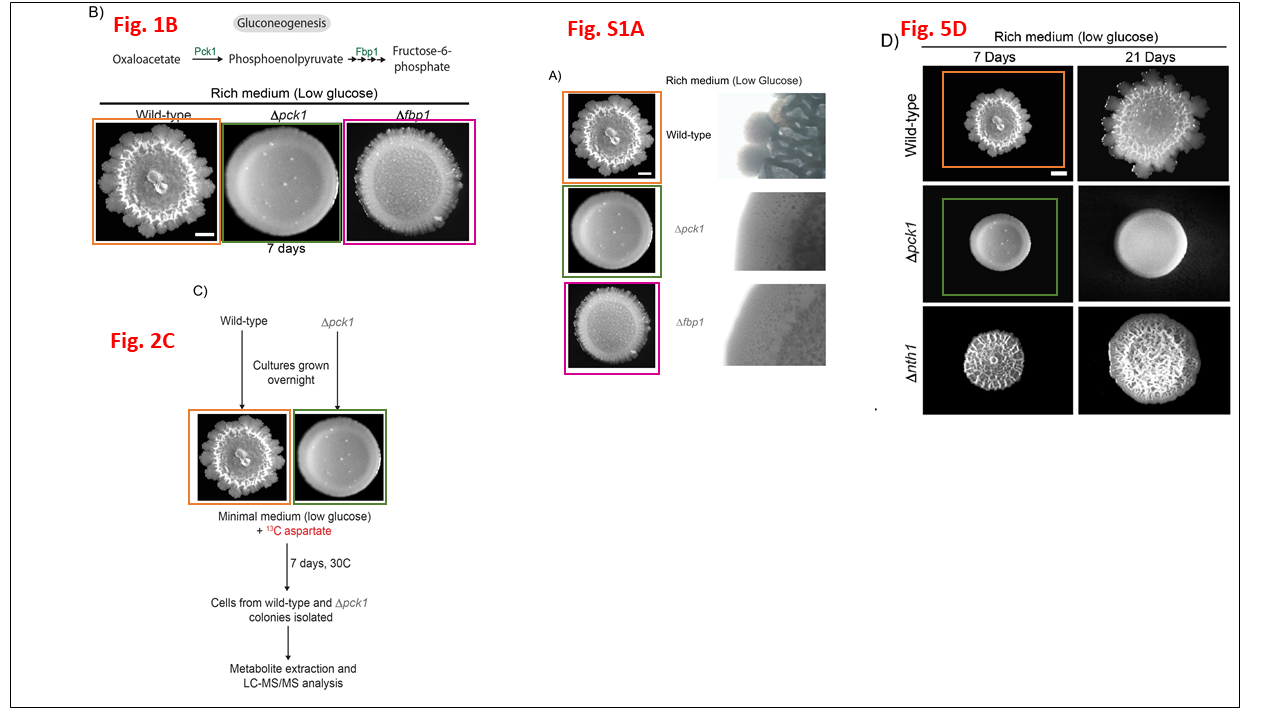
It is important to note that the NCBS retraction by Dr Laxman’s wife was merely a follow-up of a similar problem on several Indian authored papers. In addition, this fiasco sheds light on the documentation process and publication of research. A naked eye could already see the manipulations in one of the first images flagged on PubPeer. The fact that it was so strongly defended to “rest our concerns” makes me wonder if in the academic world, the pressure to publish has eroded our integrity towards the whole purpose of research?
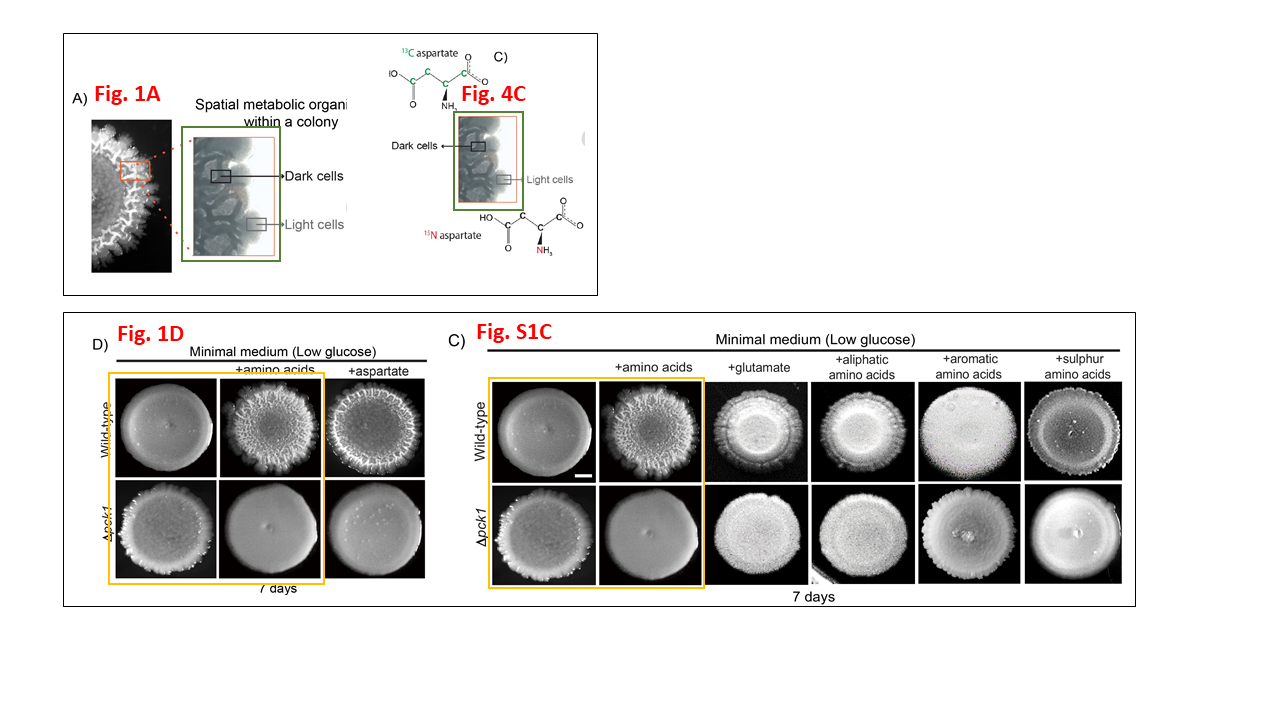
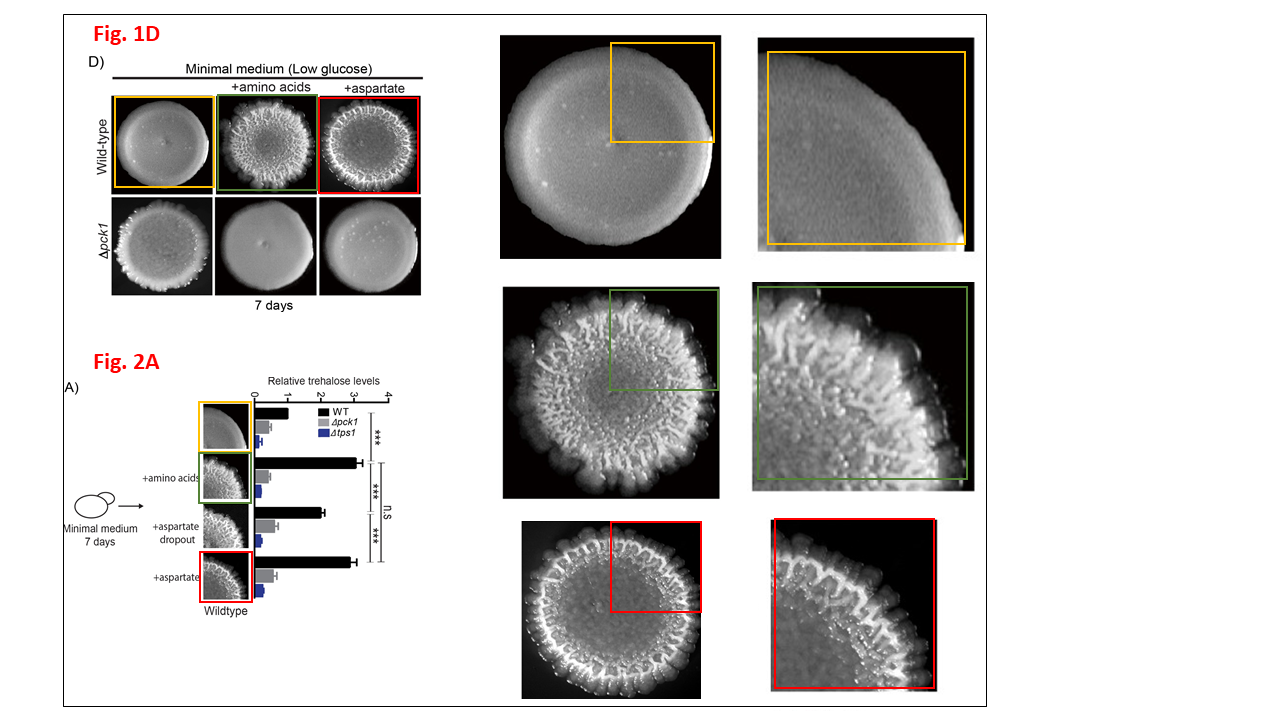
Update 14.07.2021
Look what Aneurus Inconstans found, featuring Dr Laxman.
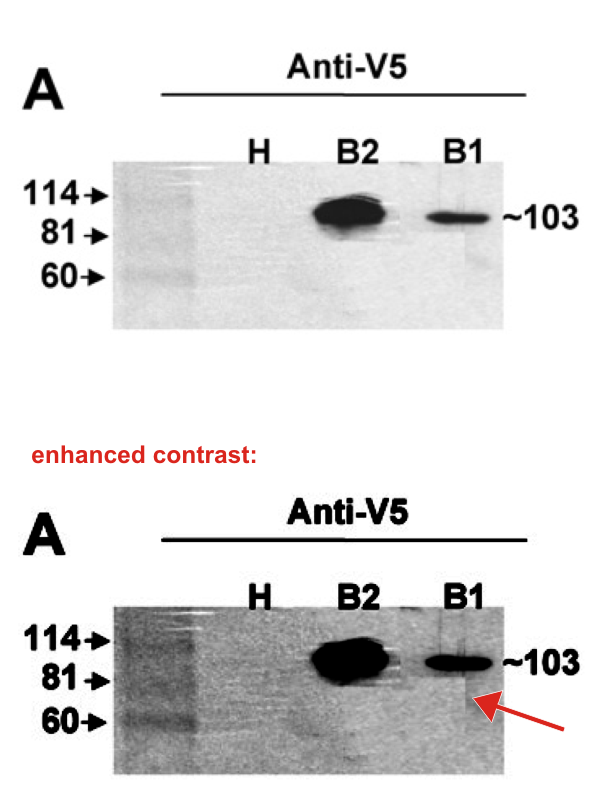
Rocío Díaz-Benjumea , Sunil Laxman , Thomas R. Hinds , Joseph A. Beavo , Ana Rascón Characterization of a novel cAMP-binding, cAMP-specific cyclic nucleotide phosphodiesterase (TcrPDEB1) from Trypanosoma cruzi The Biochemical journal (2006) doi: 10.1042/bj20060757

Last year, in December 2020, Laxman was awarded a prestigious EMBO Global Investigator grant. Because like his wife Arati, who was given a HFSP grant the year before, Sunil is that talented.

Update 2.08.2021
Here is my interview with Siladitya Bandyopadhyay:
Make a one-time donation
Make a monthly donation
Choose an amount
Or enter a custom amount
Your contribution is appreciated.
Your contribution is appreciated.
DonateDonate monthly

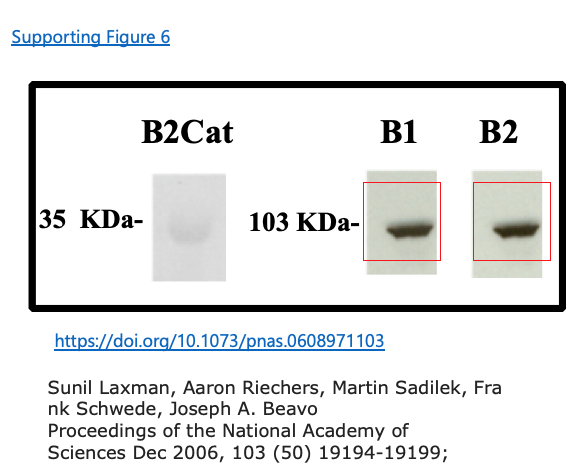

This is the scenario all over India. I have done my masters from one IIT and joined another “world class” IIT to pursue my doctoral studies . I had joined under a young, now “superstar” faculty on the field of metal catalyzed C-H activation. One fine day, when I was working in the lab, I heard from the seniors that the PI is furious. Reason? Well, he received a paper from a Chinese group as a referee .The group performed an experiment successfully which one of his graduate students failed to perform few months back . The poor student did the experiment perfectly but could not identify the product via NMR. hence the project was shelved. So, what the superstar faculty did after that? He ordered all the lab members to leave their work and next 2 days all of us were busy doing the same experiment (with a little bit of modification) as it was reported in the received paper . After 2 days, a new paper is ready from the group and submitted to a very reputed chemistry journal. Once everything is done,the PI mailed the editor that he can no longer review the paper from the Chinese group , as “our lab has already done a similar reaction and submitted to another journal”. That was the moment I knew , this is not for me. I need to find something else. Well, the paper was published though without any revisions.
LikeLike
@Leonid: I don’t want to respond to this science journalist – there are quite a few toxic ones among 21K followers. Moreover, it appears that this journalist is paid for her writings. Some one from India should check what this “Thakur family foundation” is – they are funding the writings. This journalist criticised other free lancer for having a degree in gender studies. What is this journalist’s qualification – masters in public health? Ideally, science journalists should have educated the public – it was not evident during the COVID-19 situation. Look at her writings on Covid-19 in the last one and half years. They should have done better in educating people and reducing the COVID-19 infections, instead…As they claim that they have educational background in journalism, they should used that experience in mitigating COVID-19 in one or the other way!
LikeLike
« Moreover, it appears that this journalist is paid for her writings »
Oh, how terrible. She should be working for free.
«Some one from India should check what this “Thakur family foundation” is »
Google is your friend. You can also google “Dinesh Thakur” if you like. Here.
«This journalist criticised other free lancer for having a degree in gender studies.»
Exactly the opposite of what happened. Some misogynist bigot attacked her on those grounds.
LikeLike
“Moreover, it appears that this journalist is paid for her writings”
And
“Oh, how terrible. She should be working for free.”
There is no connection between these two sentences, Rahul.
She is certainly paid for her work. How else do you think we eat or live or sustain in this world?
“Moreover, it appears that this journalist is paid for her writings” doesn’t exactly mean the monthly pay. Please understand that!! I sincerely hope you’re intelligent enough to do so!
LikeLike
Well, I also wouldn’t mind being paid for my writings. Ms Pulla probably sincerely believes (after a coaching session at NCBS) that I am a Nazi sexual harasser. Her hatred for me is strikingly personal.
LikeLike
I highlighted earlier “On the other hand, we are supposed to explain why we haven’t covered this story DAY BEFORE YESTERDAY!!!” comment by the journalist…you know the reason…If they report anything, it is not novel anymore, Leonid has the novelty being the first one to report.. I hope “thakur foundation” will take note of these things.
Thanks Paul Jones for making it clear to the other Dr Siddharthan. That is why i mentioned about the “followers”. Now you know… I thought Dr Siddharthan will reveal the journalist’s public health degree, if any!!
LikeLike
“Consent” being raised here is a red herring. It is quite clear the student was being harassed and threatened. Under those circumstances, especially if they have signed a non-disclosure agreement, the student would not like to state anywhere that they have consented to the e-mails being published.
LikeLike
Interesting to note how commonplace this may be in Indian scientific circles. For example, 3 papers have been flagged and commented on, yet none retracted, by the former executive director of Regional Centre for Biotechnology (RCB) from 2010-2015, and now Director International Centre for Genetic Engineering and Biotechnology (ICGEB, 2015 – to date). They in fact have been defended continuously by the corresponding author, who recently received an extension to his post.
https://www.jimmunol.org/content/196/2/521.1.long
https://pubmed.ncbi.nlm.nih.gov/26747566/
https://pubmed.ncbi.nlm.nih.gov/26747567/
LikeLike
I have been an undergrad at IISc, have interviewed for an NCBS position (which now I am kinda lucky that I did not clear). From my experience I can say that there are micromanaging PIs in all big Indian institutes who have horror stories associated with them. It is extremely disappointing to see so many cases of fraud plaguing the country.
LikeLike
https://www.thehindu.com/news/national/after-recall-of-paper-over-data-manipulation-ncbs-storm-over-charges-of-harassment/article35384752.ece
LikeLike
@leonid: Too bad, instead of doing a fair investigation, they block your email…. This is not right and doesn’t sound good. Please be careful. I am sure that “nothing” is going to happen – they are all well protected – i am sure you know the previous director who is the Number 1 scientist in India.
LikeLike
They are just scared that a whistleblower might talk to me.
LikeLike
@Leonid: This is what i was highlighting earlier about how Science Journalists/Journalists report without citing the original source. But Choriacts got upset about my statements. Now you see – how deccan hearld newspaper reported today…
https://www.deccanherald.com/assembly-election-2019/student-in-discredited-ncbs-study-alleges-harassment-1010627.html
LikeLike
Thanks! Now this is quality professional journalism. Steal my material and pass it off as their own investigation. They can soon start at The Guardian.
LikeLike
absolutely! too many to scrutinise (including wire…. the science journalist was complaining earlier that the other person doesn’t have a professional journalism degree. You now know why they get upset when we criticise these actions. These are professionals! No ethics!
LikeLike
Once some of the old students from the Satyajit Mayor lab start to sing this will go downhill pretty quickly for the institute. I can start, just say the word.
LikeLike
“….downhill pretty quickly for the institute.” I doubt – as long as the big boss (top scientist of India) support is there. Investigations are crucial for anything to happen.
LikeLike
Please start
LikeLike
Oded Rechavi twitter
New PI s volunteering to serve communities . Macrons neck is full of garlands. This is global now. Why point out at one country. This group think exists everywhere.
LikeLike
Interesting reads on Pubpeer on inStem scientist’s papers. It appears that many publications are being questioned. I remember that a famous Cambridge professor of Indian origin (breast cancer expert) is leading group in inStem – doesn’t he influence them at all? i am getting goose-bumps already.
LikeLike
just read the wire reporting tweeted by Dr. Bik. Unf…ngbelievable. How do you call this – if some one steals the idea and publishes on their own. Plagiarism is one thing, but this is brutal. This is what i mentioned earlier about science journalists/communicators in India. No mention of Leonid’s efforts there…the author of the wire report should be honest and do the writing in an ethically appropriate way. Not acceptable, Mr springs.
LikeLike
Visit my site on Monday!
LikeLike
Don’t see why you have your knickers in a twist, since the Wire story appears to have its own sources.
https://science.thewire.in/the-sciences/ncbs-retraction-arati-ramesh-siladitya-bandyopadhyay-inquiry-committee-research-misconduct/
LikeLike
I don’t understand “proper” journalism, i guess. In science we have something called “novelty”, if you don’t know. You need to refer to the previous publications. Probably different school of thoughts…i just don’t agree in stealing things from others. Acknowledgement would be good.
LikeLike
Pingback: “On no condition can the prediction be wrong” – NCBS Scapegoat Student in Interview – For Better Science
Pingback: And The Weak Suffer What They Must: A Critical View of the NCBS Retraction Scandal – Notes on the Academy